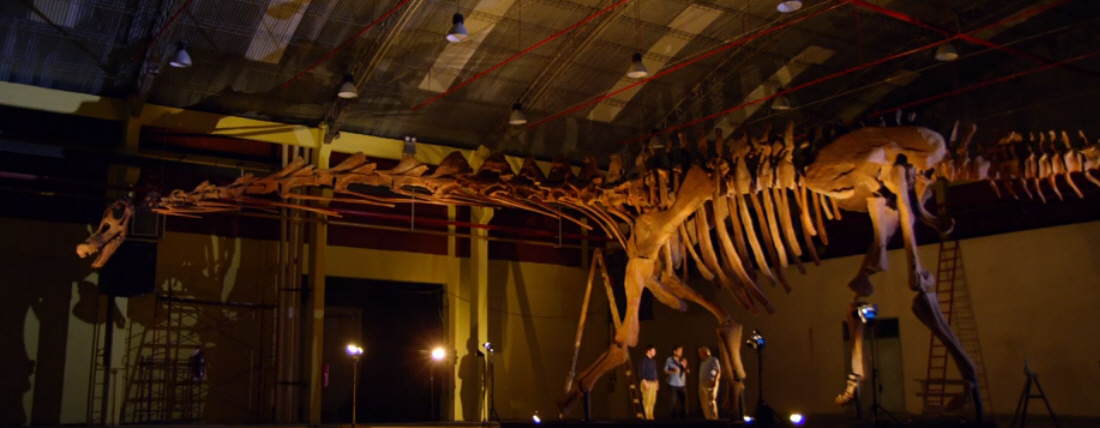Reconstructing the Titanosaur Skeleton
Two years after the dig began, a strange cargo arrives, having made a 7,000 mile journey from Canada. Dozens of packing cases later and all the bones are finally in Diego’s warehouse ready for reconstructing the titanosaur skeleton.
Assembling the skeleton can finally begin. The 3-D data used to make the skeleton has also been used to create a computer model. It means I can get a preview of what the final skeleton will look like.
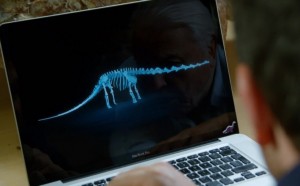
The heavy tail counterbalances the exceedingly long neck. But judging from the size of the muscle attachments, the tail was also immensely strong.
The long and painstaking examination of the backbone has now borne fruit and Ben has got some important news.
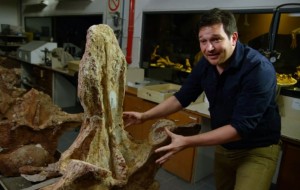
Ben Garrod “This is a vertebrae here from right high up in the back, right near the shoulder blades. And the most important thing is this little ridge that ends in this big lump and this is only found in this particular dinosaur so from that and a few other physical difference, we think we have got a brand-new exciting species.”
David Attenborough “So our titanosaur is not only a giant, it is indeed a new species of dinosaur. Examining the spinal bones also reveal something about how it coped with life as a giant.”
Ben Goddard “This is where the spinal cord would have passed.”
David Attenborough “So this hole straight through here? The whole nerve centre, as it were, the cable carrying all the nerves.”
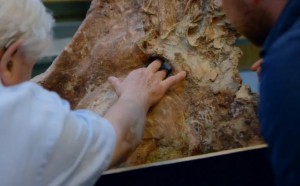
Ben Goddard “From the base of the tail right to the skull.”
David Attenborough “It’s very small.” Ours is what?”
Ben Goddard “About thumb width.”
David Attenborough “So it’s not all that much bigger. This cord was well over 100 feet long. It would have taken about a second for a nerve impulse to go from its tail to its brain. And what’s more, the spine has revealed another surprise, It is full of holes, rather like a Swiss cheese.
The neck bones of titanosaurs contain so many holes and spaces that they weighed around 35% less than they would have done had they been made of solid bone. The leg bones of modern birds are much the same. And those spaces serve another very important function. They contained air sacs. These air sacs were connected with the lungs. So what was their function and how did they work? They occupied much of the chest and ran along the whole length of the body along the backbone to the 17-metre-long neck and then to the head.
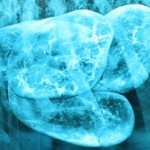
It’s thought the balloon-like sacs had thin but strong membranes. These sacs acted like bellows, forcing air into the lungs. When we breathe in, air flows down into our lungs, oxygen is absorbed in exchange for carbon dioxide which is then got rid of when we breathe out. The air sac system is very much more complex but very much more efficient.
It enabled the titanosaur to take in oxygen continuously, not just when breathing in but also when breathing out.”
David Attenborough “Our titanosaur wasn’t the only giant living around here. This was a dangerous world, where meat-eaters were giants too. New evidence from the dig site shows that carnivorous dinosaurs were here as well.”
Dr Diego Pol “So these are some of the over 80 teeth we found at the dig site. And you can feel how sharp they are.”
David Attenborough “Oh, yes, it’s serrated, just like a shark’s tooth, in fact.”
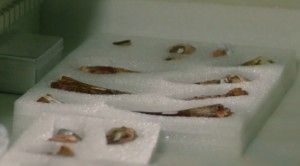
Dr Diego Pol “Absolutely. They actually belong to a family known as a shark-toothed dinosaurs. We can identify the teeth at a family level. We know of one species that belonged to that family, it’s called Tyrannotitan chubutensis.”
The dig is coming to an end and the team have assembled a record-breaking number of bones but they’re still hoping to find one last piece of the puzzle – the skull.
David Attenborough “So what number’s this, 203?”
Dr Diego Pol “Actually, this is 223.”
David Attenborough “If these are neck vertebrae, could they be leading towards a skull?”
Dr Diego Pol “Yes, that’s what we’re hoping for.” We just found another neck vertebrae over there. There are only three titanosaur skulls known so far. So they’re very rare.”
David Attenborough “And that’s because they’re very fragile?”
Dr Diego Pol “They’re very delicate bones and they have very light sutures between each of the bones.”
The scientific team has discovered, collected, cleaned, scanned and copied 220 bones of our giant. Soon it’ll be possible to put those copies together to get some idea of what the living animal looked like.
But the fossil bones themselves still have many secrets that are waiting to be revealed.
It takes two weeks, working day and night, to fit all the bones together.
David Attenborough “Well Diego, are you pleased with it?”
Dr Diego Pol “Yes, we are very pleased. It has been a lot of work, it has taken 40,000 man-hours to get here but we’re really, really happy with it.”
Reconstructing the Titanosaur skeleton has been a labour of love, but the result is a magnificent recreation of this colossus of the dinosaur world.
